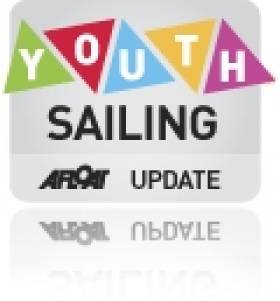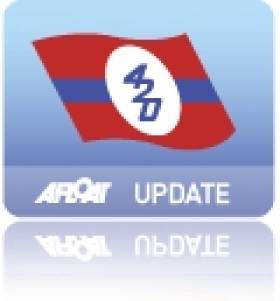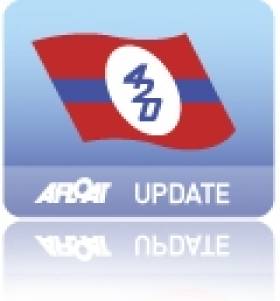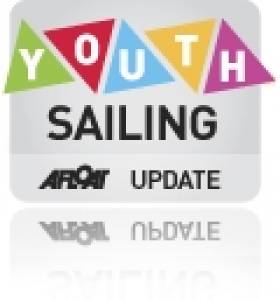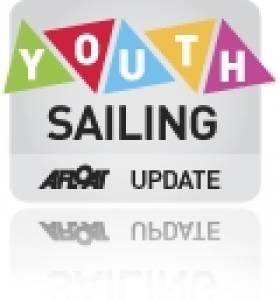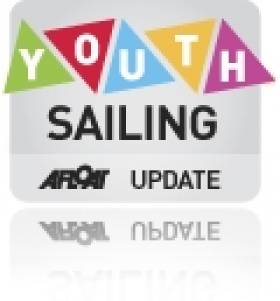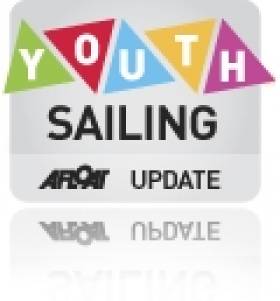Displaying items by tag: 420
Youth Boat Selection Requires Leadership
There has been a call for the Irish Sailing Association (ISA) to take a lead in the big decisions that face youth sailors on what classes to sail to after they leave the ranks of the Optimist, Topper and Feva classes. The call comes from a leading junior organiser who does not wish to be named.
Although youth sailing is buoyant in Ireland it is known there is a 'high attrition rate' among teenagers. The lack of transfer in to senior dinghy classes has been a cause of concern for many clubs around the country.
The comments follow a recently published article on Afloat.ie promoting the RS 200 dinghy as a progression boat for juniors.
"We need a class that will keep youths engaged. The 420 and 29er are great boats but require higher levels of boathandling, are much more competitive and tend to attract the top sailors"
"While the ISA's Olympic ambitions are great to see, it will fail the sport as a whole if it does not tackle this gaping need, the organiser says.
Read the RS 200 article by Ciara Byrne and the junior organiser's comments here
RS 200: the 'ideal' next step for Irish Youth Sailing?
Questions over the next step for juniors after the RS Feva point to the bigger RS200 writes Feva sailor Ciara Byrne
The RSFeva has become the world's best selling two-person dinghy in recent years with fleets also growing in clubs all over Ireland. It is fast becoming the most popular and widespread choice for teenagers and youth sailors who enjoy competitive, active and exciting sailing.
However many questions were being asked recently at the RSFeva Nationals, held in Crosshaven, Co. Cork, regarding the next step for young, talented sailors who wish to continue racing in large fleets without the difficult transition of transferring from the Feva into a larger, unfamiliar dinghy. This uncertainty has led to many sailors dropping out of sailing altogether, while the remainder have split the fleet into Lasers, the 420/470 or moved on to cruisers.
However these dinghies require a lot of time and effort of getting used to, leaving some sailors frustrated and also, less motivated. To avoid this altogether, there is one simple solution: the RS200.
The RS200 is a spacious, one-design, double-handed, hiking, high-performance dinghy which has developed a huge following at club, circuit and championship level in the UK with a growing fleet in Ireland. A pivoting centreboard and rudder allow easy launch and recovery with a thwart giving the crew a comfortable position for light winds. With the asymmetric spinnaker, similar rigging and a similar design, it can be considered as a larger and faster Feva which makes for an easy changeover and the most logical and simple step up.
The ideal weight for an RS200 is 115-145kg (18-23 stone) which allows people of all ages to sail and race effectively in this dinghy. Ideal for teenagers emerging from the Feva, parents, youths, couples, friends and relatives can also come together which enhances the family and social scene.
Even though the 420 has a larger total sail area, the RS200's asymmetric spinnaker of over eight square metres, with a smoother single line hoist and drop system, similar to the Feva's. makes for a faster boat and requires greater tactical and more exciting downwind sailing. This encourages competitive racing and enhanced racing skills.

An RS200 at full speed off Greystones. Photo: Fiachra Etchingham
A maintenance free hull, made of lightweight polyester GRP ensures a long competitive life and second hand boats can be in very good condition so that older hulls are without the disadvantage experienced in fleets such as the 420. Furthermore, every hull comes from the same manufacturer giving no subtle advantage to any one boat; therefore racing just comes down to the sailors' tactics, boat handling and general knowledge of sailing and racing.
While the RS200 is not an Olympic class, there are large UK and Irish fleets which are active and competitive. Johnathan Lewis, a UK Feva coach and RS200 sailor, strongly encourages Feva graduates to move into the RS200 as it is an easy transition and makes for fun and exciting sailing. RS200 fleets are strong in Irish clubs such as those in Northern Ireland including Ballyholme, Newcastle and Cushendall as well as Greystones Sailing Club in Co. Wicklow.
Greystones Sailing Club boasts probably the largest asymmetric dinghy fleet in Ireland with fifty five asymmetric dinghies, twenty one of those being RSFevas and the majority of the remainder being RS200s. Recognising the RS200 as the natural progression from the Feva, ages range from fifteen to fifty five across the RS200 and RS400 fleets in the Club, with most of these boats competing in national events in Ireland, and some in the UK and further afield.

Rounding a mark in the RS200. Photo: Fiachra Etchingham
As fleets build in Dún Laoghaire and Howth yacht clubs, the RS200 is gradually becoming a popular progression from the Feva, and with the RS400 as a follow on boat for larger crews, young sailors can remain involved and spirited in asymmetric racing. The RS200 satisfies a thirst for speed and pace which generates more exciting, competitive and enjoyable sailing for those emerging from Feva fleet.
A Dublin Sailor (who has asked not to be named) has sent us comments on this story:
As one involved in junior and youth sailing at club level, one of the big decisions that faces youths is where to go after junior classes such as Optimists, Toppers, Fevas. Like any other sport, there is a high attrition rate after the age of 14 / 15, especially among girls which is an even greater shame as they can compete on a par with the guys.We need a class that will keep youths engaged. The 420 & 29er are great boats but require higher levels of boathandling, are much more competitive and tend to attract the top sailors. They also suffer from an inability to match up crews who will stick together - teenagers chop and change all the time and its difficult to race a boat like a 420 / Fireball / 29er wihout a constant crew partnership.
We need a boat/class that:
- Enables swapping around of crews without a major impact on the boathandling / teamwork. A sailor's plans for the weekend / event / season are not scuppered because of crewing issues.
- Does not need a highly competent crew (e.g. ability to trapeze and fly / gybe a kite etc.) so that sailors can sail with their mates who may not necessarily be top-notch sailors but who can acquit themselves well in a slightly less complex boat.
- Has a good mixed social scene which is the most important element of any class, youth or otherwise.
- Does not cost the earth in terms of purchase price, is easy on wear & tear on kit (hence replacement & upgrade costs) or does not go soft and become uncompetitive needing a new hull after three to five years etc
- Has international competition that is closeby (UK, FR, Bel, Ned etc) for those aspiring to a bit more
- Has a motiviated class structure to help grow the class.
The fear is that we are starting out another class that will dilute the current youth class efforts. However I believe that the 420 and 29er will hold their own and continue to attract top sailors with ISAF ambitions.
On the other hand, if we continue to support these we will continue to lose the middle ground (and majority) of young sailors from our sport. Youths are fickle enough and if its too much hassle to deal with all the challenges of getting afloat they just won't bother - sad but true.
The ISA needs to take a lead in this and while its Olympic ambitions are great to see, it will fail the sport as a whole if it does not tackle this gaping need in its portfolio of support.
I believe that the RS200 and R2400 provide the best solution to these challenges. They appear well-built and the manufacturer certainly appears well organised and gets involved.
Looking from outside and without any vested interests (other than the health of junior and youth sailing) the RS's get my vote as a class that can make a radical difference.
Murphy Stays in Top Ten at Youth Worlds
In spite of two thirtieth places scored in today's penultimate rounds Irish sailor Sophie Murphy stays in the top ten of the ISAF Youth Worlds in Zadar, Croatia. The Royal St George Yacht Club and Quoile Yacht Club Laser single-hander struggled in day fives stronger breezes, the first of the competiton.
Murphy can stay top ten, an important target, if she has a good final race tomorrow morning.
420 duo Emma Geary from Royal Cork Yacht Club and Niamh Connolly from Baltimore Sailing Club were definitely back on form today having been hampered by yesterday's lighter winds. The girls relished the medium breeze today placing 10th and 6th respectively in their two races. They lie 18th overall.
Philip Doran of Courtown Sailing Club and the National Yacht Club caught up to 12th place during his first race of the day but lost out on the final downwind which saw him finishing in 22nd. He fared better in his second race sitting fifth for the duration until the final mark when he was yellow flagged, the penalty saw him finish ninth leaving him 15th overall.
Meanwhile, Maxime Mazard (FRA) and Giovanni Coccoluto (ITA) go into the final day of racing at the 41st ISAF Youth Sailing World Championship in Zadar, Croatia with just one point separating them in the Laser Radial Boys fleet.
The Frenchman, who has led for the majority of the week, finished 25th and seventh today and has seen his five point overnight lead reduced to a single point after Coccoluto came seventh in Race 10 before discarding his disqualification in Race 11.
The final race tomorrow will decide who takes the gold medal home for their nation and it should be a fascinating finale.
RYA Volvo Team GBR sailor Cameron Douglas shone in the breeze today finishing with a bullet and a second place, he said, “It was an awesome day. We had a bit of breeze for the first time this week so I’m very happy. It has been a really great event.”
Australia’s Matthew Wearn won the days other race but did not finish Race 11 and is down in 26th place and Žan-Luka Zelko is third on 114 points trailing Mazard by eight points.
In the Laser Radial Girls Erika Reineke (USA) also finished with a race win and a second place. The American, who is a full time member of US SAILING’s Team Alphagraphics, said, “I liked today a lot better. There was a little bit of breeze and there was some nice waves. I was pretty far away from the gold today, 19 points, and I think I caught up a bit. I’m just going to go out and try my hardest tomorrow and try to win.”
Tiril Bue regained the lead in the Radial Girls fleet after she was consistent in the breeze finishing third in Race 10 and fourth in Race 11. Overnight leader Paulina Czubachowska came through in 10th and 11th today and has dropped to third overall. Manami Doi (JPN) maintains her second place overall but just two points separate Doi, Czubachowska and Reineke so it should be an interesting climax.
And like the Laser Radial Boys it will be winner takes all between Veronica Fanciulli (ITA) and Siripon Kaewduang-Ngam (THA) with just one point separating the pair in the RS:X Girls. Fanciulli went 2-4 today and Kaewduang-Ngam finished third and recorded a bullet to pull the overnight deficit down to a single point. Naomi Cohen (ISR) is third on 32 points and Agnieszka Bilska (POL), who claimed the days other bullet, is fourth on 36 points.
With three bullets today Louis Giard has leapt into second place in the RS:X Boys on 36 points. But Cho Wonwoo (KOR) continues to lead and will take a six point advantage into the final day following three RS:X races today. The Korean finished 2-4-6 today. Spain’s Mateo Sanz had a minor dent in his scorecard today following a tenth place in Race 9 but bounced back with a third and second. He is third overall on 37 points.
Morgan Kiss and Christina Lewis (USA) closed the gap on 420 leaders Lara Vadlau and Tanja Frank (AUT) to four points ahead of the final day. The Americans finished 4-5 today compared to the Austrians 8-2. Nikole Barnes and Agustina Barbuto (ISV) retain their third place following two seventh place finishes today. Today’s race wins went to Carrie Smith and Ella Clark (AUS) and Maelenn Lamaitre and Aloise Retornaz (FRA).
2010 ISAF Youth Worlds gold medallist Jordi Xammer with new crew Alex Claville regained the lead in the 420 Boys following a tenth and fourth place finish. They lead Japan’s Daichi Mototsu and Yuki Hino by eleven points. Angus Galloway and Alexander Gough (AUS) stay in third place going into the final day and have a two point advantage over Guillaume Pirouelle and Valentin Sipan (AUS)
In the SL16 Brazil’s Martin Lowy and Kim Andrade take a 13 point lead into the final day after they came eighth twice today. And with a fleet of 14, the boys from Brazil will need to sail a steady race tomorrow to seal the deal. Nicolaj Bjornholt Christiansen and Daniel Bjornholt Christiansen (DEN) had a good day coming second and third and are second overall on 37 points. And Great Britain’s Rupert White and Nikola Boniface are third on 48 points.
Carlos Robles and Florian Trittel have an impressive 19 point lead ahead of the final day after a bullet and a sixth place finish in the 29er. The Spaniards have only finished out of the top six twice and with a string of consistent results it would be hard to bet against the Spaniards claiming gold. The race for second place is interesting with Max Deckers and Annette Duetz (NED) on 51 points, Antoine Screve and Max Agnese (USA) on 53 points and Josh Franklin and Lewis Brake (AUS) on 56 points. The days other race win went the way of France’s Gael Jaffrezic and Julien Bloyet who are down in eighth place.
One race in each fleet will take place tomorrow to decide the medals and racing begins at 12:00 local time.
Coaching Clinic in Advance of 420 Connachts
Galway Bay is laying on coaching ahead of racing at the 420 Connacht championships on July 2nd.
Coaching is available for all prospective participants, whether seasoned racers or sailors new to the class.
The coaching clinic will be run by GBSC and will include Will Leech, Rob Lehane and Ruardhri de Faoite.
Participants can come for either a 5 day (Mon-Fri) or 3 day (Weds-Fri) coaching clinic. This will give sailors who have spent lots of time stuck in their books to blow away the cobwebs and get fully tuned-up for the championship racing at the weekend.
John Leech, PRO for championship remarked: "GBSC is delighted to welcome the 420 fleet back to Galway Bay for the Connacht Championships. Galway is a superb centre for sailing activity as was demonstrated when the Volvo Ocean Race visited. It's a great opportunity for visiting 420 sailors to enjoy good racing and have some fun with the active fleet of 420s based here."
Details of racing are in the attached NOR. The entry form can be used to sign-up for the coaching clinic too.
Entry Costs:
Racing fee - €80 per boat
5 days coaching (27 June-1 July) fee - €200 per boat
3 days coaching (29 June-1 July) fee - €170 per boat
Coaching entries with fees must be received by 20th June - Cheques payable to GALWAY BAY SAILING CLUB.. Entries for racing only will be taken on the morning of 2nd July.
420 Class Releases Instructional Video
The International 420 Class Association has launched a free online Training Video (scroll down for video) to provide coaching and training tips for both the beginner and experienced 420 sailors. Sailors are always looking for ways to improve their sailing techniques, improve manoeuvres and get the most out of the time spent on the water and this online resource is set to provide a significant step towards this objective.
The International 420 Class dinghy is an ISAF International Class and two-person dinghy for young sailors. The 420 is an established worldwide performance two-person trapeze and spinnaker racing dinghy and the world's top youth training boat, which is used as the selected equipment at the ISAF Youth Sailing World Championships - offering the perfect pathway from youth to Olympic sailing.There are 56,000 420 dinghies worldwide, sailed at school, club, open, national and international levels. There are many second hand boats available, active clubs and excellent tuition for all levels. In April a brother and sister Patrick and Chloe Crosbie from Royal Cork Yacht Club won the Irish 420 title. In July Emma Geary and Niamh Connolly will represent Ireland at the ISAF Youth Worlds in the Girls Division, racing a 420.
José Massapina, 420 Class Vice-President responsible for the 420 Development Programme commented, "Training and improving techniques can be challenging and this instructional video is a bit like having your own personal video coach to help you get faster and talk you through skills and tactics." Recognizing the input from the partners involved, Massapina added, "We are delighted to have produced the video which has been a major project for the class and I am confident it will benefit many young sailors around the world. Our thanks to Nick Drougas, the Greek sailors sailing and demonstrating the techniques and Icarus who have produced the video."
This is the first specific training video produced by the International 420 Class Association and introduces a range of specific techniques, and demonstrates how to master them in different wind and sea conditions and what to consider when undertaking a range of manoeuvres.
"If you get your technique right you'll be efficient, produce better results and avoid potential injuries." explained Nick Drougas the world class coach behind the video. "Boat set up is explained, alongside body and boat movement. The commentary and visual presentation provide an easily understood training tool. Watch the video, go out and practice, review your day's sailing and improve your skills." he added.
Animated graphic overlays demonstrate specific points to consider in completing manoeuvres, accompanied by an excellent voice over. Designed to help sailors improve their skills and sail their boats better, the video provides a free and excellent resource for 420 sailors around the world. Coaches can also benefit from the video and look at new approaches to training and coaching.
Developed by the International 420 Class Association in partnership with Nick Drougas and Icarus – the training video is broken down into easily digestible sections, which you can view as separate video clips. The video focuses on:
Preparation and General Skills
Lightwinds
Medium Winds
Strong Winds
In addition to the English version, the videos are also available to download in French, Spanish and German. If ISAF MNAs or 420 National Class Association would like a translation of the video into any other languages please contact José Massapina on: [email protected]
Brother and Sister are 420 National Champions
| Rank | CLASS | SAIL NO | HELM | CREW | CLUB |
|---|---|---|---|---|---|
| 1st | 420 | 53156 | Patrick Crosbie | Chloe Crosbie | Royal Cork YC |
| 2nd | 420 | 53836 | Aodh Kennedy | Daniel Browne | Kinsale YC/Tralee Bay YC |
| 3rd | 420 | 53698 | Emma Geary | Niamh Connolly | Royal Cork YC/Baltimore SC |
| 4th | 420 | 51743 | Tara Flood | Lucy Bolger | Howth YC/Royal St George YC |
| 5th | 420 | 53103 | Richard D'Esterre | Peter Stokes | Royal Cork YC |
| 6th | 420 | 53116 | Fiona Daly | Patrick Daly | Tralee Bay SC |
| 7th | 420 | 53206 | Donal Collins | Jack Collins | Galway Bay SC |
| 8th | 420 | 1 | Cian Walsh | Aaron O'Reilly | Galway Bay SC |
| 9th | 420 | 53701 | Jack Lee | Ciaran Jordan | Galway Bay SC |
| 10th | 420 | 53160 | Alva McDermott | Aislinn Irvine | Lough Ree YC/Royal St George YC |
| 11th | 420 | 49678 | Orlagh Thompson | Lizzy McDowell | Malahide YC |
| 12th | 420 | 50611 | Alanna Lytttle | Cian Guilfoyle | Royal St George YC |
| 13th | 420 | 50288 | Annabel Elliott | Amelia O'Keeffe | Royal St George YC |
| 14th | 420 | 51987 | Emily Jones | Liadh Conway | Wexford Harbour BTC |
| 15th | 420 | 49688 | Daniel Gilmer | Alex Elliott | Royal St George YC |
300 Top Junior Sailors Bound for Dublin Bay
Over 300 sailors will compete in Dublin Bay in seven different classes (Laser Radial, Laser 4.7, 420, Feva, Topper, SL16 and Optimist). For youth sailors, this event is the most important in the annual calendar as it is the decider for the top Irish sailors to compete internationally during 2011 and is the pathway for future Olympic sailors. Podcast with Olympic Team Manager James O'Callaghan here.
The 420 fleet is already in situ as the Leinster Championships were held over Easter and the girls team Emma Geary and Niamh Connolly won the event in style. This team is the only 420 crew to qualify internationally for a place on the Irish team to compete in the ISAF Youth Worlds in Zadar, Croatia and will be looking to win next weekend to secure this honour.
Dublin Bay will host the 2012 ISAF Youth World Championships and this year's ISA Mitsubishi Youth National event is an important test event with representatives from the international sailing authority visiting Dun Laoghaire to view plans and test logistics.
In addition to the 420 fleet the Laser radial fleet will also be competing to qualify to represent Ireland in Croatia. Philip Doran aged 17 from Courtown in Wexford is the current former under 17 World Champion in the Laser Radial fleet although the National title has eluded him so far. In the girls fleet it will be a toss up between Saskia Tidey (RIYC) and Sophie Murphy (Quoile YC) as both already have a national title each under their belts.

A fleet of top Optimists are expected. Photo: Bob Bateman
The younger Optimist fleet is also celebrating this week after two top 5 positions at the Easter Regatta in Braassemermeer, the Netherlands. In fact an Irish team has competed at this event for 23 years and this is the first time that Ireland has won the country prize. Sean Donnelly from Dun Laoghaire who finished fourth in Braassemermeer is also leading the Optimist fleet in the trials and will be anxious to hold on to first position during the ISA Mitsubishi Youth Nationals.
In other fleets, the laser 4.7 fleet is enjoying record numbers with many ex-Optimist and Topper sailors choosing this boat. Finn Lynch from Blessington and Seafra Guilfoyle from Cork will be firm favourites to win the class.
Overall Dublin Bay will be a spectacle of sail over the May Bank holiday weekend with light winds forecast.
Mitsubishi Motors have been a proud supporter of junior sailing in Ireland for the last 7 years. In recent years Ireland has had successes at youth level with winner of the girls under 21 Laser World Championships and a top 10 at the 2010 ISAF Youth Worlds and wins at the British National Optimist Championships.
Youth Worlds Places Up for Grabs on Dublin Bay (Podcast)
Olympic team manager James O'Callaghan has played a big role in bringing on Irish team talent. Results have been achieved in recent times in the Topper, Laser 4.7 and Radial and 420 but a top result in the youth worlds would make all the effort worthwhile.
Ireland's best ever Youth Worlds result came in 1996 when Laura Dillon and Ciara Peelo took bronze in the Laser II dinghy. The stated aim for 2012 is to at least equal this result and win a medal on the home waters of Dublin Bay.
Listen to the podcast below to hear O'Callaghan's take on the front runners for April's important Youth selection event.
Watch a preview for July's ISAF Croatian Youth Worlds Event below
Bank Holiday Youth Champs to Expect 300
May Bank Holiday weekend (29 April – 02 May) over 300 sailors will compete in Dublin Bay in seven different classes (Laser Radial, Laser 4.7, 420, Feva, Topper, SL16 and Optimist). For youth sailors, this event is the most crucial in the annual calendar as it is the decider for the top Irish sailors to compete internationally during 2011 and is the pathway for future Olympic sailors.
Not only will the ISA Mitsubishi Youth Nationals over the May weekend be an important event for youth sailors it is also a major milestone for the organisers of the ISAF Youth Worlds 2012 as it offers them the opportunity to test drive the logistics of managing such a large event incorporating three clubs, three race courses and hundreds of volunteers.
'Dun Laoghaire has a proud reputation for hosting international events such as the biennial combined clubs Dun Laoghaire Regatta and numerous world championships. However in 2011 the ISA Mitsubishi Youth Nationals is of more significance as it gives us an opportunity to test our systems in advance of the ISAF Youth Worlds 2012.' stated Event Chairman Brian Craig.
Dun Laoghaire won the bid to host the ISAF Youth Worlds 2012 from 12-21 July when, in excess of 300 sailors and windsurfing champions from over 60 nations will participate. The granting of this prestigious sailing event to Ireland is a major boost to the sport and secures Ireland's position as an ideal location for hosting world class sailing events. It also establishes Dun Laoghaire as one of the prime major racing locations in the world, capable of running multiple classes and courses to the highest international standard.
'The Youth Nationals is a significant event on the racing calendar. It involves young sailors from all of the 'Olympic Pathway' classes, some of whom are competing for places on the team that will represent Ireland in the ISAF Youth Worlds later this year. In recent years Ireland has had successes at youth level with winner of the girls Laser World Championships a top 10 at the 2010 ISAF Youth Worlds and wins at the British National Optimist Championships.
Three hundred sailors from around the country are expected to compete for national youth and junior pathway titles and the Mitsubishi coaching grant during the event.
Cumann Seoltoireachta an Spideil Host 420 Champs
A field of top class visitors and local crews saw former 420 Champion Rob Lehane and crew Tom Mapplebeck, who are currently campaigning a 470 revel in the fresh conditions to take the Connacht title ahead of Patrick Crosbie and crew Thomas Chaix and local father and son team of Stephen & Ronan OGorman.
The silver fleet was hotly contested and CSS Spiddals own up and coming team of Sam Kinirons and Oisin Hamilton took the trophy on a countback from Brendan Gallagher & Rory McAdam of GBSC with a third place overall in the first race.
Racing was cancelled due to strong winds on Saturday and the sailors and supporters enjoyed an evening BBQ hosted by CSS members Carmel & Tiernan OBrien.
4 Races were ran by Race Officer John Leech on Sunday in freshening South Westerlies with at times poor visibility in showers. The fleet and especially the many young 420 crews showed great seamanship in dealing with the testing conditions on this exposed coast, which is no doubt a great encouragement to the 420 Fleet.































